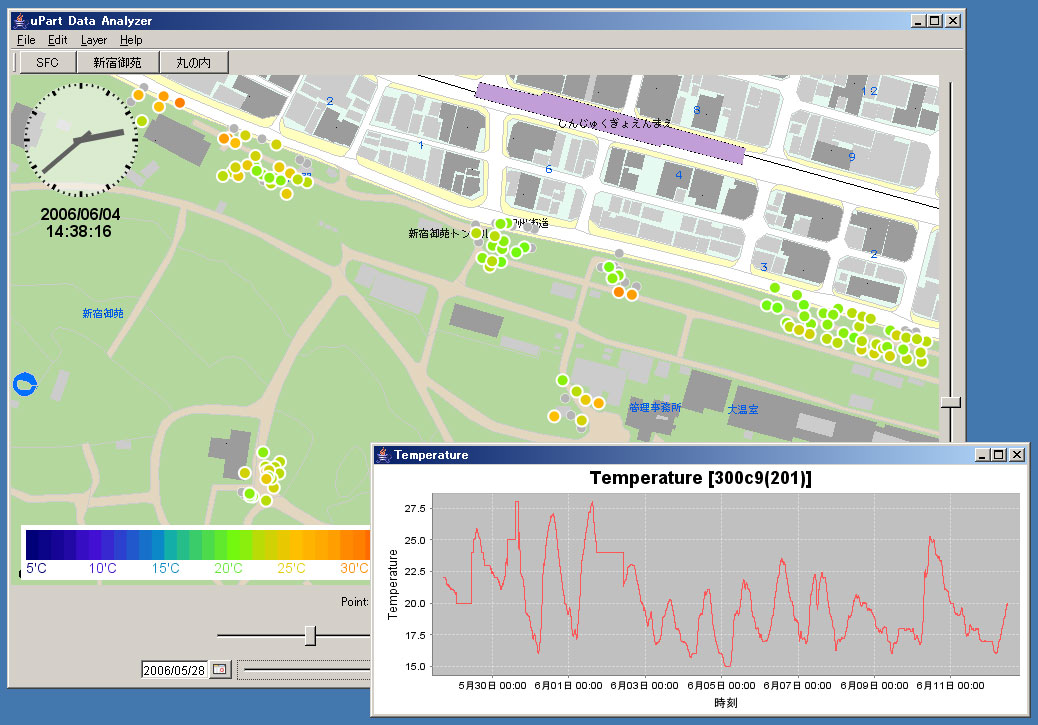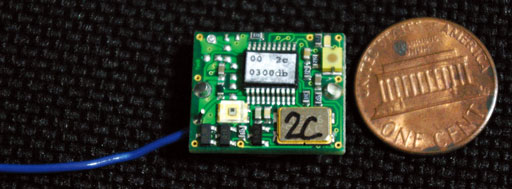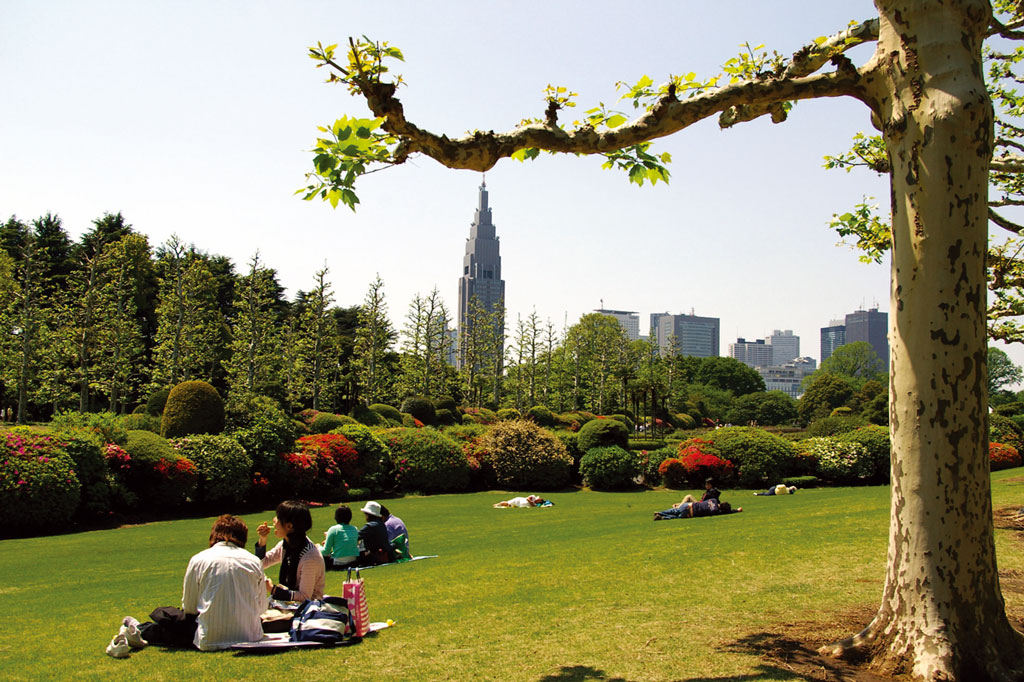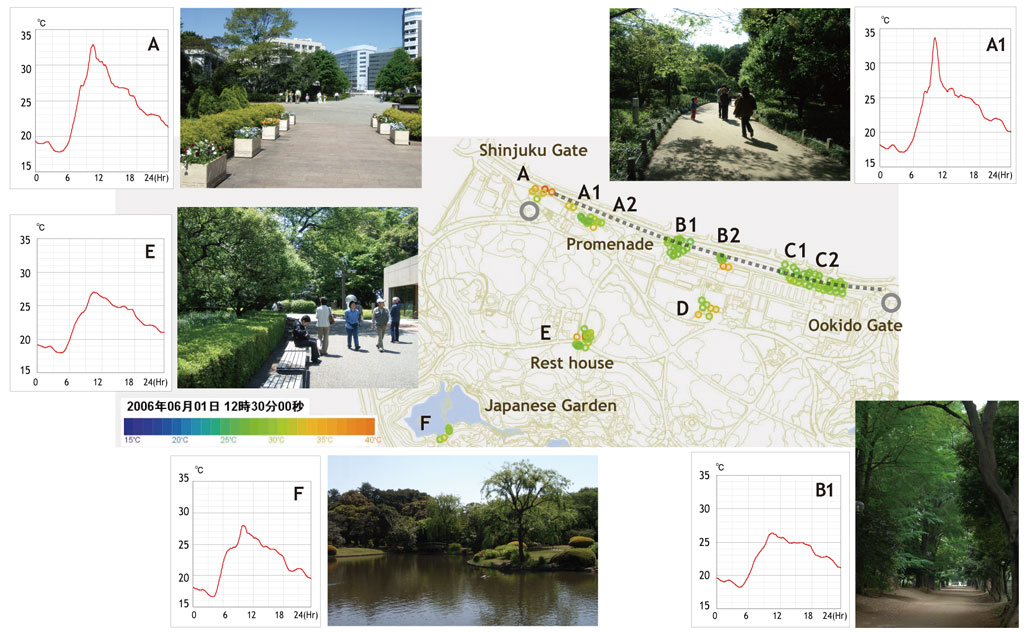Airy Notes
In Airy Notes project, we monitored environmental condition using tiny sensor modules and showed the characteristics of places intuitively on map and on cell phone. The Airy Notes system is designed to help easy understanding of the effect of greening by enabling high density placing of sensor nodes. We conducted the experiment of the system in Shinjuku Gyoen with 160 sensors. The garden is known as taking part of keeping urban environmental condition calm with its green. We monitored the change of temperature, and observed that the temperature of the inner place was lower than the edge of the garden.
We started Airy Notes Project in April 2006 by a team of ubiquitous computing researchers and landscape design researchers. The aim of the Airy Notes Project is to develop monitoring system of natural environment, and develop a new method for environmental management utilizing the system. In this paper, we introduce the activities of the project.
1. Airy Notes Project
In the Airy Notes Project, we developed the software system of environmental monitoring which helps people to understand the characteristics of their close environment. Airy Notes imply that the sensor unit records the change of the environment just by putting it to any places as if we take notes. We believe the simplicity accessibility to the environmental data would change our attitude to the environment.
1.1. Airy Notes System
Airy Notes is an environmental monitoring system that uses wireless sensor nodes. The system measures micro scale environmental conditions with a large number of sensors. This section shows the features and elemental technologies of the Airy Notes System.
1.2. Features
On-site Observation
Airy Notes System enables on site observation of current temperature and its temporal change on a cell phone of any user. As shown in Fig.1 , users can casually see the characteristics of the environment by checking QR- code on the sensor at the point they are in. They would understand the environmental condition with their body sensation.

Real Time Monitoring
The data shown on the viewer are updated in real- time. Unlike existing environmental monitoring system which usually use a sensor module with storage, Airy Notes System utilizes wireless sensor nodes, and online database system. Users can see the latest condition of the environment anytime. Fig.2 is a map on which live temperature are shown as colors.

Easy Installation
Airy Notes System supports the installation with a sensor installation assist application running on a tablet PC. In the installation of sensors, registering the detailed information of the location and its environment is significant. In addition to the latitude and longitude of the location and the height, the visage of the ground, the amount of sunshine, and the vegetation need to be registered. When a installer place the sensor to the monitoring area, s/he can easily plan and register locations and conditions of every sensor with the application.
1.2 Sensor and Technology
Followings are important technologies to develop Airy Notes System.
uPart Wireless Sensor System
We adopted uPart wireless sensor system(Beigl, 2006) for Airy Notes, which is one of the advanced prototype developed in the Telecooperation Office(Teco), Karlsruhe University. uPart sensor is equipped with temperature, light, and movement sensor (Fig.3). The sensor system is cheap enough to arrange numerous sensors to monitor large area , and maintenance-free with long battery life. Every sensor node only has a simple transmission mechanism, and requires a receiver within 30m from uParts.

Sensor Package
We developed a package for uPart sensor module to protect it from rain and the sunlight (Fig.4). The package was made of paper for the cost and easiness of production. The shape is effective in the accurate measurement of temperature. It was also designed to interest visitors in the experiment with the eye-catching color and the logo.

Sensor Database
We developed software system for managing sensor data collected from a number of sensors. We designed an open API for exchanging sensor data based on XML/ HTTP technology. The interface supports collection and distribution of sensor data in real time. The API does not depend on specific sensor architecture. Developers can easily develop applications that deal with sensor data with geographical location using the XML interface.
2. Experiment
We had conducted an experiment of Airy Notes System in Shinjuku Gyoen for the event of the centennial anniversary. The experiment aimed to show the heat environment of the park to visitors of the event.
2.1. Shinjuku Gyoen National Garden
Shinjuku Gyoen National Garden is a large city park of 58.3ha located in Shinjuku ward, constructed on the site of a private mansion of "daimyo"(feudal lord) (Fig.5). The park is popular as sightseeing spot and place of recreation and relaxation. Shinjuku Gyoen also plays the pioneering role in approach to environmental problems. Recent research is revealing that Shinjuku Gyoen plays a significant role for improvement of the heat environment of the surrounding area (Mikami, 2006).

2.2. Evaluation
We evaluated following capabilities of the Airy Notes System in the experiment; 1) Time and effort for building infrastructure, 2) Ability for monitoring by comparing the acquired data with the past researches, and 3) The method to report condition of environment to visitors. The event was held in 3 June, and our experiment took three weeks including construction of infrastructure. We start this project April, 2006, and we have fewer two months to prepare preparation.
2.3. Infrastructure and Application
The sensors were set in multiple places in Shinjuku Gyoen and the rooftop of Shinjuku Ward Office which was located outside of the garden to monitor various environments. We chose 10 spots in the garden considering the utilization of existing network that reach to buildings in the garden. Six spots were along the promenade (A, B1, B2, C1, C2), D is around the management office, E is around the restaurant, and F was beside “Kamino-ike” pond in the Japanese garden. We set totally 160 sensors for the experiment. We show the data collected from the sensors on a computer screen in the event place, and delivered the data to cell phones of visitors.
2.4. The Result of the Experiment
It took 6 days for total to install Airy Notes system to Shinjuku Gyoen by about 3 people a day. For the first three days, we set up network infrastructure and XBridge receivers. In the latter days, we put about 15 sensors around each XBridges. We set about 15 sensors around the receivers and set 150 sensors for total in Shinjuku Gyoen and 10 sensors in the rooftop of Shinjuku Ward Office. Almost all sensors worked well during the experiment except a few sensors which were broken by crows.
Environment in Shinjuku Gyoen
The map-based viewer presented that the temperature became lower in order of business area (G), the border between business area and the Garden (A), the garden field (E, F, D), the forest in the Garden (A1-C1). In the area where the trees particularly grew and made shades in the promenade, the diurnal temperature was lower and changed slowly (B1 C1). In the border between business area and the Garden (A), the temperature became higher and rose rapidly. Also the temperature in the Japanese garden droped rapidly rather than the other areas (Fig.6). Past researches in Shinjuku Gyoen revealed the phenomenon that woods on the ground without pavements prevent sudden rise in temperature, and the grass with much radiation cooling and less latent heat makes cool-island in the night. The result of our monitoring fit to the past researches, even the data were fewer for the full analysis. It shows that the system is useful for environmental monitoring.

Application
When visitors walk around in Shinjuku Gyoen, they could see the change of temperature of the place s/he was in. Visitors found that the more the observation spot is distant from the business area and has more green, the lower the temperature became. Visitors could also see the distribution of temperature on a map (Fig.7). The response of the visitor showed that they understood the characteristics and the role of the environment of Shinjuku Gyoen.

3. Conclusion
We developed a basic method of environmental monitoring using ubiquitous computing technology in the project. A large number of sensors enabled finding fine characteristics of the environment. The characteristics were effectively reported to visitors, since they could see the result of the monitoring in real time and on site. The environment of Shinjuku Gyoen is typical one and has various elements of the environment in urban area. The success of our experiment in Shinjuku Gyoen indicates that our technology and method owing to the ubiquitous computing technology will be helpful in making good relation between people and their close environment. Also, this project was a challenge of collaboration of researchers who have different research backgrounds. We took long time for discussing and sharing the aim of the project; thus we could apply the most advanced technology to the actual experiment.
Publications
- Masaki ITO, Yukiko KATAGIRI, Mikiko ISHIKAWA, Hideyuki TOKUDA, "Airy Notes Project: Creating Landscape Planning Method for the Ubicomp World," International Workshop on Hybrid Design Practice: Situating Ubicomp's Interdisciplinarity, In Conjunction with Ubicomp 2009, pp. 89-90, Sept, 2009.

- Masaki Ito, Yukiko Katagiri, Mikiko Ishikawa, and Hideyuki Tokuda, “Airy Notes: Environmental Monitoring by Wireless Sensor Network System for Landscape Planning,” Journal of Information Processing Society of Japan, Vol.49, No.1, pp 69–82, Jan. 2008.
- Masaki Ito, Yukiko Katagiri, Mikiko Ishikawa, Hideyuki Tokuda, "Airy Notes: An Experiment of Environmental Monitoring for Improving Urban Environment Using Tiny Wireless Sensor Modules," Sixth Annual IEEE International Conference on Pervasive Computing and Communications (PerCom 2008) Demonstration, Hong Kong, March, 2008.
- Yukiko Katagiri, Masaki Ito, Hideaki Tokuda, Mikiko Ishikawa, "Development of Environmental Information System for Citizen Participation based on a Ubiquitous Monitoring System," Proceedings of International Symposium on City Planning 2007, 474-482, Yokohama, Japan, August, 2007.
- Masaki Ito, Yukiko Katagiri, Mikiko Ishikawa, Hideyuki Tokuda, "Airy Notes: An Experiment of Microclimate Monitoring in Shinjuku Gyoen Garden," Fourth International Conference on Networked Sensing Systems (INSS 2007), pp.260--266, Braunschweig, Germany, June, 2007.
